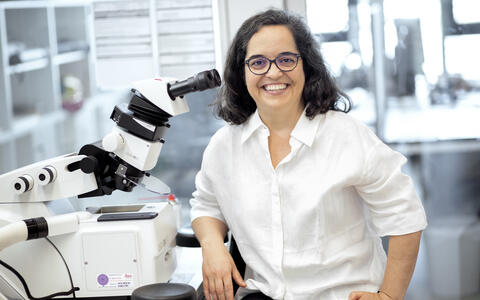The art of DNA folding
A single moment can change a person’s life forever. The first hit of a drug that is highly addictive. A momentary experience of incredible fear that returns, repeatedly, as trauma. A viral infection that causes a chronic disease. Most people tend to see such phenomena as tragic, but for Ana Pombo they also pose a scientific challenge. She wants to know how these events are inscribed in our genes. What happens in our DNA at such moments? And would it be possible to undo the changes? And even cure the addiction or the trauma at the level of our genes? “That is a big dream of mine,” says Dr. Pombo. ”But only when we understand the mechanisms by which our genome ‒ which represents the totality of our DNA ‒ works will we be able to influence it.”
Ana Pombo
In order to achieve this goal, the professor carries out basic research at the Max Delbrück Center for Molecular Medicine (MDC). A native of Portugal, Dr. Pombo, 50 years old with thick dark hair and black-rimmed glasses, walks through her laboratory, which teems with activity. Young researchers are sitting together in small groups before a computer, taking turns pointing at the screen and discussing something in English. “That’s what I like the most,” says Dr. Pombo, “seeing everyone engaged in discussion with one another.” The 14-strong interdisciplinary team has members from ten different countries, including the United States, Russia, the United Kingdom, Iran, and Spain. Dr. Pombo sits at a table in the center of her office. This is her favorite place, because here everyone can gather around it. Plus, the office’s floor-to-ceiling windows give her a panoramic view of Berlin-Mitte, which is also home to nearby Charité.
Genes are like ingredients at a cook’s disposal
The research group on Epigenetic Regulation and Chromatin Architecture, which Dr. Pombo has led at the MDC’s Berlin Institute for Medical Systems Biology (BIMSB) since 2013, investigates the interplay between gene regulation and genome architecture. The researchers observe active, resting, and dividing cells, as well as healthy and sick cells. They aim to decipher the rules by which the genetic information in our cells is constantly read and processed. “Our genome – the totality of our DNA – is like a thick book,” says Dr. Pombo. The body seeks out exactly the information it needs at any given moment. It activates or blocks certain sections of DNA and switches genes on and off.
When explaining her work, Dr. Pombo frequently uses metaphors. “The some 20,000 genes in everyone’s body are like the ingredients that cooks have at their disposal,” she says. “There are different results depending what they do with the ingredients.” The scientist is interested in the underlying recipes. What genes do the body use and to what extent? And in which order and at what point in time?
Ms. Pombo, who is also a professor at Humboldt-Universität, has always been inquisitive, even as a child. “I always wanted to know exactly how complex systems work,” she says. Whether it concerned the natural world, the human body, or society, it didn’t matter. “Perhaps that’s why today I get the most joy from researching things you can’t actually see.” She initially studied biochemistry at the Universidade de Lisboa in Portugal before going on to study in the United Kingdom at the University of Oxford, where she did her PhD work. She was a professor at Imperial College London prior to coming to Berlin.
Gender imbalance
While Dr. Pombo was growing up, she wasn’t even aware that she could become a scientist. “There were no such role models in my life,” she says. Today she believes it is particularly important to encourage and support female colleagues. She regularly speaks at networking events and takes part in mentoring programs in Germany and abroad. “We should all ask ourselves why there is still such a gender imbalance in our profession,” she says.
Dr. Pombo’s own experience has shown that a female researcher can achieve a good balance between career and family. “A career in science requires hard work and long hours,” she says. “But your schedule is flexible.” When her own daughter, now 15, was small, she spent most evenings with her. After her daughter had gone to bed, she would work several more hours on her computer. “I attended more of my daughter’s school parties and sporting events than most of the parents who had nine-to-five jobs.” In her own lab the percentage of male and female employees is exactly 50-50. “This is pretty easy to achieve,” she says.
A certain type of genes has particularly captured the interest of Dr. Pombo. These genes are in a “poised state,” an alert mode in which they are ready to become active at any time. When a stimulus strikes, they can respond quickly for example during early development. They are like runners who have warmed up for a race. As soon as the starting gun is fired, they can spring into action. However, changes in the mechanisms that keep these genes repressed later in life can trigger the onset of disease. This may play a role in the development of cancer.
Genes become neighbors by intricate DNA folding
Ana Pombo bought the microscope in her early twenties on a flee market in Brussels as she was deciding where to go and what to do for her PhD. It represents her fascination with the opportunity to look at biochemistry inside cells. It`s not a standard microscope – but one that is re-invented, made of very simple parts used in new ways. „This microscope is an inspiration to look at problems with new eyes, to create with simplicity,“ she says.
The work by Dr. Pombo and her team shows that not only is the sequence of the genetic letters of DNA vital to the functioning of life, but that their spatial arrangement plays a central role too. Almost everyone is familiar with the images of outstretched DNA strands that resemble a ladder. But these strands have to be folded into tiny packages to fit in the cell’s nucleus. The DNA lies in the nucleus like tangled strings. Though it looks like a confused mess, the folding process brings genes that are far apart on the linear DNA strand in close contact. “Different regions congregate on the chromosome because they have something in common,” says Dr. Pombo. “Genes regulated by similar principles are brought closer together through the folding process.” But according to her, these rules don’t always apply. “It’s like in the institute’s cafeteria,” says Dr. Pombo. “Sometimes you sit with colleagues from your immediate team, but other times with someone you know from other projects.”
In 2017, Dr. Pombo presented a technique in the journal Nature that makes it possible to map the 3D structure of the entire genome. Genome architecture mapping (GAM), as it is called, allows scientists to more easily determine which regions on the DNA prefer to interact with one another. “We now want to apply this mapping method to specific disease situations,” says Dr. Pombo. This includes diseases with complex origin such as autism and epilepsy. A new study has just begun to investigate the effects of lifestyle choices such as sleep deprivation and drug addiction on the genome of brain cells.
Dr. Pombo believes her many plans can be best realized in Berlin at the MDC. Here, she is Deputy Scientific Director of BIMSB: “Berlin is a wonderful place to practice science and raise a family,” she says. Even outside the lab, she feels very comfortable in the German capital. She loves her apartment near Bundesplatz and enjoys exploring the city with her family, especially its markets, parks, and lakes. “It’s important to me that my work helps to educate and raise awareness,” says the biologist. “If I can show how a certain diet, cigarette smoking, or too little sleep can affect our DNA,” she hopes, “maybe some people will approach these issues with more awareness.” Dr. Pombo still has a lot to accomplish.
Text: Alice Ahlers








